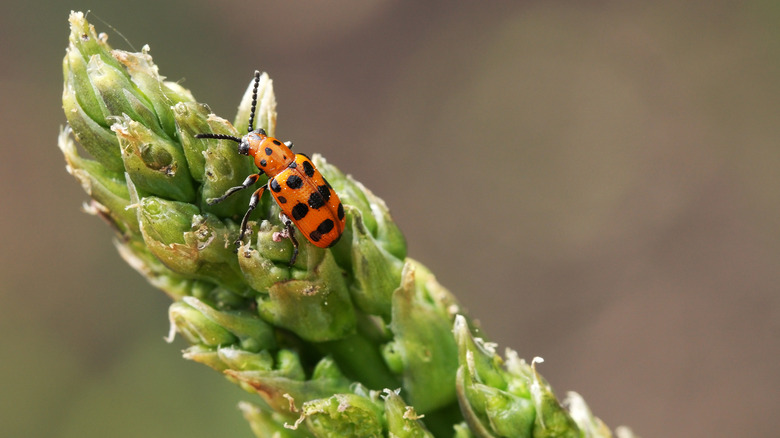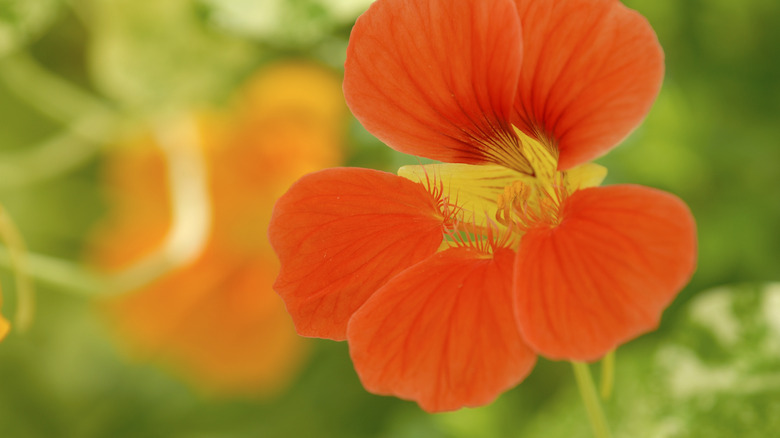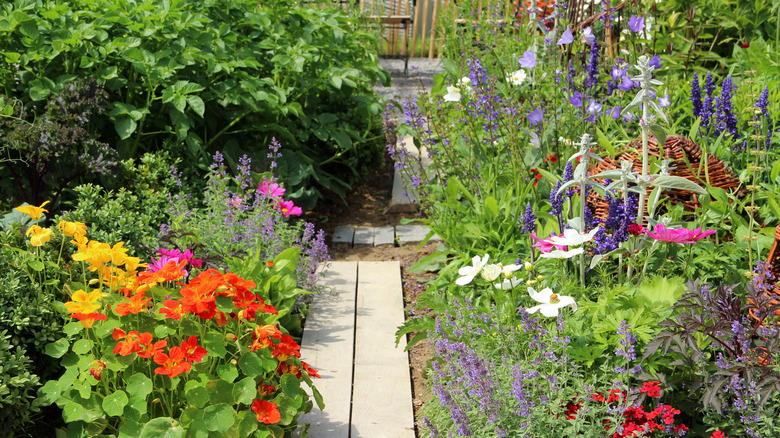The Flowering Plant That'll Keep Pests Away From Your Asparagus In The Garden
If you're currently growing and nurturing an asparagus garden or planning to start one, the thought of lush, healthy vegetables might be at the forefront of your mind. Along with the excitement comes the concern of pests. Cutworms, aphids, and asparagus beetles target asparagus plants. Asparagus beetles chew on spears and foliage, causing browning and defoliation. Aphids suck sap, leading to weakened plants and distorted growth. Cutworms, meanwhile, cut down young asparagus shoots at the base, hindering plant development. Fortunately, there's a natural, effective solution to this problem: nasturtiums. Nasturtiums (Tropaeolum) originate from South and Central America. The scientific name, derived from the Latin word "tropaeum," reflects their unique foliage. They benefit asparagus in many ways. They act as excellent companion plants, supporting the growth and health of your asparagus.
There's more to nasturtiums than just being pest bouncers. They're like a magnet for beneficial insects, especially pollinators, which are crucial for a healthy, thriving garden. Plus, their vibrant flowers can jazz up your garden, adding a splash of color alongside your green asparagus fronds. Thanks to its trailing habit, it is perfect for creating a cascading effect in hanging baskets or covering the ground in garden beds. Growing nasturtiums is a straightforward and rewarding task. They are resilient plants and aren't too picky about soil, making them a great choice for gardeners of all levels. They can still thrive in less fertile, but well-drained soil with a mildly acidic pH.
Understanding nasturtiums: origin, appearance, and varieties
Research has shown that nasturtiums are quite a powerhouse in the garden, especially when it comes to repelling pests. A 2022 study published by the Journal of Functional Foods revealed that nasturtiums are rich in metabolites such as isothiocyanates, compounds known for their pest-repelling properties. Another 2022 study published by Scientific Reports investigated a specific metabolite derivative, allyl isothiocyanate (AITC), highlighting its potential as an effective biopesticide. While nasturtiums are great at repelling certain pests like aphids, they also act as a natural trap crop. This means they attract pests like squash bugs and aphids, keeping them away from your asparagus. It's a clever and organic way to manage pests, and it's not just a gardening myth; there's solid science backing it up. Trap crops like nasturtiums are also known as sacrificial crops. When used as a companion plant, you also preserve the enemies of aphids and other bugs that feed on your asparagus since you avoid using harmful pesticides. The quality of your asparagus plants is something else to consider. Using pesticides on asparagus can lead to soil contamination and potentially leave harmful residues on the produce. Over time, it may also contribute to pest resistance and disrupt the natural balance of the garden ecosystem.
Cultivating nasturtiums: soil, water, and sunlight requirements
When using nasturtiums as a companion plant or trap crop, the trick is to get them in the ground before your asparagus starts sprouting. This way, they'll be all set up to do their job right when needed. There are a few ways to go about this. One method is to plant nasturtiums around the edges of your garden. Think of it as setting up a colorful little fence that pests find irresistible while keeping them away from your main crops like asparagus. Alternatively, you could mix things up a bit with alternating rows. This way, the nasturtiums are spread out, protecting more of your garden. This method is called intercropping and offers a more integrated approach to pest management. It also allows for easier access to both crops during the maintenance and harvesting phases.
If you're feeling a bit adventurous, why not just scatter nasturtiums randomly around the garden? It's less structured, sure, but it creates a more natural look and can be just as effective. Whichever method you choose to use, you might have to plant nasturtiums every 2-3 weeks to provide effective control. Planting is a breeze. Just pop your nasturtium seeds directly into the soil, about half an inch deep, and leave about 12 inches of space between them. Nasturtiums are pretty laid-back and don't need much fussing over, which is great whether you're a gardening newbie or a seasoned pro.


